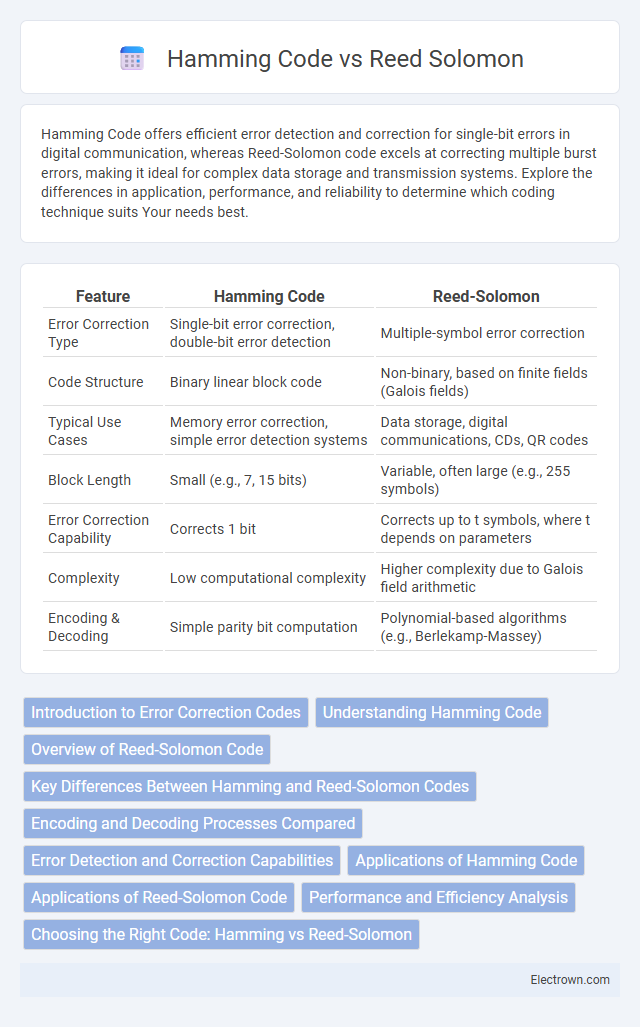Hamming Code offers efficient error detection and correction for single-bit errors in digital communication, whereas Reed-Solomon code excels at correcting multiple burst errors, making it ideal for complex data storage and transmission systems. Explore the differences in application, performance, and reliability to determine which coding technique suits Your needs best.
Table of Comparison
| Feature | Hamming Code | Reed-Solomon |
|---|---|---|
| Error Correction Type | Single-bit error correction, double-bit error detection | Multiple-symbol error correction |
| Code Structure | Binary linear block code | Non-binary, based on finite fields (Galois fields) |
| Typical Use Cases | Memory error correction, simple error detection systems | Data storage, digital communications, CDs, QR codes |
| Block Length | Small (e.g., 7, 15 bits) | Variable, often large (e.g., 255 symbols) |
| Error Correction Capability | Corrects 1 bit | Corrects up to t symbols, where t depends on parameters |
| Complexity | Low computational complexity | Higher complexity due to Galois field arithmetic |
| Encoding & Decoding | Simple parity bit computation | Polynomial-based algorithms (e.g., Berlekamp-Massey) |
Introduction to Error Correction Codes
Error correction codes like Hamming Code and Reed Solomon play a crucial role in ensuring data integrity during transmission and storage by detecting and correcting errors. Hamming Code is primarily used for single-bit error correction in binary data and operates with relatively low redundancy, making it suitable for real-time systems and memory error correction. Reed Solomon codes offer more robust error correction capabilities by handling burst errors and multiple symbol errors, widely applied in digital communications, QR codes, and data storage devices to maintain reliability across noisy channels.
Understanding Hamming Code
Hamming Code is a linear error-correcting code designed to detect and correct single-bit errors in transmitted data using parity bits strategically placed at specific positions. It relies on a matrix-based encoding and decoding process that simplifies error detection through syndrome calculation, enabling efficient error correction in noisy communication channels. Hamming Code's balance between redundancy and error correction capability makes it suitable for applications requiring low overhead, such as memory systems and real-time data transmission.
Overview of Reed-Solomon Code
Reed-Solomon code is a powerful error-correcting code widely used in digital communications and storage systems, notably for correcting burst errors. It operates on symbols rather than bits, allowing it to efficiently detect and correct multiple errors within data blocks. Compared to Hamming code, Reed-Solomon provides stronger error correction capability, making it ideal for applications like QR codes, CDs, and satellite communications where data integrity is critical.
Key Differences Between Hamming and Reed-Solomon Codes
Hamming codes are primarily designed for single-bit error correction with relatively low redundancy, making them suitable for small error rates in memory or communication systems. Reed-Solomon codes provide robust error correction for multiple symbol errors, commonly used in digital storage and transmission like CDs and QR codes, leveraging block-based error correction over larger alphabets. Your choice depends on the error model and correction needs, with Hamming codes optimal for simpler, single-error scenarios and Reed-Solomon codes excelling in complex, burst-error environments.
Encoding and Decoding Processes Compared
Hamming Code uses binary linear block encoding with parity bits strategically placed to detect and correct single-bit errors, enabling straightforward syndrome decoding for error correction. Reed-Solomon coding operates on symbols and employs polynomial arithmetic over finite fields, encoding data as polynomial coefficients and decoding using algorithms like Berlekamp-Massey to correct multiple symbol errors. The complexity of Reed-Solomon decoding surpasses Hamming's syndrome approach, providing stronger error correction capability at the cost of higher computational resources.
Error Detection and Correction Capabilities
Hamming Code provides single-bit error correction and double-bit error detection, making it suitable for environments with low error rates and simpler fault tolerance. Reed-Solomon codes excel in correcting multiple symbol errors and erasures, commonly used in data storage and communication systems where burst errors occur frequently. Your choice between these codes should reflect the complexity of the error patterns and the level of fault tolerance required for your application.
Applications of Hamming Code
Hamming Code is widely used in computer memory error detection and correction, particularly in single-bit error correction for RAM modules and cache memory. It is also applied in digital communication systems to improve reliability in low-noise environments such as satellite and wireless transmissions. The code's simplicity and efficiency make it ideal for real-time error correction in embedded systems and microcontrollers.
Applications of Reed-Solomon Code
Reed-Solomon codes are widely applied in digital communications and storage, including satellite transmissions, QR codes, and CD/DVD error correction, due to their strong burst error correction capabilities. Unlike Hamming codes, which handle single-bit errors, Reed-Solomon codes excel in correcting multiple symbol errors, making them ideal for environments prone to burst errors or data loss. Your data integrity benefits significantly in systems like digital broadcasting and data storage by employing Reed-Solomon coding techniques.
Performance and Efficiency Analysis
Hamming Code offers low-complexity error correction focused on single-bit error detection and correction, making it efficient for systems with limited processing power and low-latency requirements. Reed-Solomon code provides robust multi-symbol error correction, excelling in burst error environments at the cost of higher computational complexity and increased latency. Your choice depends on balancing performance needs and efficiency constraints, favoring Hamming for lightweight applications and Reed-Solomon for high-reliability data transmission.
Choosing the Right Code: Hamming vs Reed-Solomon
Hamming Code excels in correcting single-bit errors and detecting double-bit errors, making it ideal for simple, low-latency applications such as memory error correction in computer systems. Reed-Solomon Code is preferred for complex data error correction, handling burst errors efficiently in storage devices, digital communications, and QR codes. Your choice depends on error patterns: use Hamming for single-bit errors and low overhead, while Reed-Solomon suits environments requiring robust correction of multiple, clustered errors.
Hamming Code vs Reed Solomon Infographic

 electrown.com
electrown.com